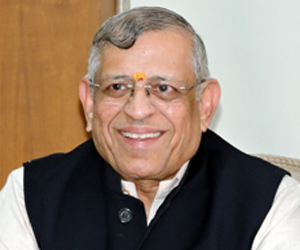From being an intensely hated person, he has become the most admired world leader in just 10 years.
Like the US presidential elections, the Indian parliamentary polls too attract the world’s attention. For two reasons. India’s emergence on the global stage and Prime Minister Narendra Modi’s rise as a global leader. Both are intertwined. Modi’s rise was more than a miracle. For over a decade, he was relentlessly demonised within and the world over as some mini-Hitler. From being an intensely hated person, he has become the most admired world leader in just 10 years.
The world viewed with awe how he transformed India’s economy from the Fragile Five to the fifth most powerful. Rising from being detested to glory, Modi headed the G20 nations last year. Today, the Italian Prime Minister says Modi is “world’s most loved leader”, the Australian Prime Minister calls him “the boss”, the US President says that Modi is so popular that he “feels like taking his autograph”.
Why do the developed nations so endearingly admire the man for whom they had visceral hatred? One has to connect the hidden dots to get at the answer to this question. The developed nations saw China, which was on par with India three decades back, vault over India by miles. Despite being democracies themselves, they got convinced that Chinese autocracy was more efficient than Indian democracy. They admiringly valued the autocratic China and discounted the democratic India. Against this background, India’s all-round rise under Modi was a revelation, if not a shock, to the West.
Democracy slows India’s development – the West
In an article titled “Why China flew, India just grew?” (2019) Forbes magazine asked how the Chinese economy, India’s equal in the 1980s, became 3.5 times bigger than its neighbour’s by 2014. Forbes credited China’s swift ascent to its efficient autocratic system and cited cumbersome democracy as the reason for India falling behind.
To drive home its point, Forbes compared the timelines of the Narmada dam in India and the Yangtze dam in China. The Yangtze project submerged 13 cities, 140 towns, 1,350 villages and displaced 1.2 million people and yet China completed it in just 12 years.
The Narmada dam affected no city, no town and only 178 villages and displaced one lakh persons. Yet, India took six decades to complete it. Reason? Protests against the dam by the Narmada Bachao Andolan (NBA) and others.
On the NBA petition, the Indian Supreme Court first stopped the dam in 1995. Four years later it reduced the height and allowed it. Then it gradually increased the height bit by an average of 2½ metres per year in 20 years to its original 139 metres! The dam now drives the development of Madhya Pradesh, Maharashtra and Gujarat. Like Forbes, corporate lobbies portrayed the Indian democratic system was growth-resistant, Chinese autocracy as growth-friendly, imaging China as contributor to global prosperity. That had struck a deep chord in the West. This was when a Modi highly distrusted by the West took over as India’s Prime Minister.
‘Not democracy, unstable govts’ – Modi
When the West was portraying democracy as slowing India’s development, Modi must have been laughing within himself. As the chief minister of Gujarat, he had posted spectacular achievements under the very democracy trivialised as incompatible — with faster growth. Even though the media was unfriendly, it repeatedly judged him as the best chief minister. Modi knew that India’s slow development was not the fault of democracy. It was rickety-to-weak coalition governments in India that stunted our growth for over two decades.
See the facts which the West lost sight of about the Indian democracy. As the world began opening up, in 10 years, when China had just one leader, Deng Xiaoping, India witnessed the rise and fall of seven Prime Ministers. Some of them ruled for just months and even days — V P Singh 11 months, Chandrasekhar four months, Narasimha Rao five years, Vajpayee 13 days, Deve Gowda 11 months, Inder Gujral 11 months, and Vajpayee 13 months. India saw four general elections as governments fell like ninepins.
The latter Vajpayee-led coalition did well on different fronts but he had to manage a coalition of 25 parties to remain in power, which eroded his efficiency. Later, Manmohan Singh led a multiparty coalition. Remote-controlled by Sonia Gandhi and often humiliated by Rahul Gandhi, he ended up heading a scam-ridden and non-performing government, which reduced India into a Fragile Five economy in the world, in semi-bankrupt state.
Even its acclaimed growth was finance-led, jobless growth – with workforce shrinking from 56.4% to 50.7% in its high growth years, adding just 2.8 million jobs. It was in this background that Modi became the BJP prime ministerial candidate in 2014. The charismatic Modi launched a blitzkrieg, addressed over 700 rallies, and struck a chord with the electorate who handed him a historic majority.
Transforms India
The re-emergence of a stable government and strong leader after a quarter century attracted the attention of the world that had internally written off India as an also-ran country. With a hardworking, capable and determined leader at the helm, India started off at a hectic pace. Modi had a plateful of issues. He had to battle against the deliberate demonisation of him by vile global and national adversaries. He succeeded in removing the blot wantonly cast on him.
Simultaneously, he launched the monumental task of transforming the national polity and psyche and reviving the shattered economy. And he succeeded. The scale of his success was unprecedented. The scale and pace of his work and success shocked the world, which had, for decades, caricatured India as a slow-moving elephant.
His out of the box and bold economic measures like demonetisation, GST, bank account for all the unbanked, Direct Benefit Transfer, Swachh Bharat, Ayushman Bharat, housing for the homeless — all stunned the country and some of them, the world itself. Each one was accomplished within the days, months and years stipulated.
Over 50 crore bank accounts, the construction of 12 crore toilets, the distribution of 11 crore free cooking gas connections, two crore homes for the rural people and enrolment of 100 crore citizens for Aadhaar cards – each of them unprecedented in scale even globally – all accomplished within the scheduled dates. The liberal world began adoring him. Modi’s scale and speed have made the Forbes kind of perceptions vanish in the global discourse on India.
Most popular leader
The US business intelligence company, Morning Consult, a trusted outfit, has been rating how popular are the leaders of 23 democracies, including the US and all EU nations. It has been consistently rating Modi for the past five years as the most popular leader in the world. This testifies to Modi’s stature today. It will not be an exaggeration to say that Modi has saved the credibility of Indian democracy in the Western world. He has also made them seek India. Without the strength of the Indian democracy, the liberal democratic West, which is just 13% of global demography, will be anaemic. And more.
Liberal democracies are facing serious challenges from huge inequality coupled with Chinese influence over their discourse. Post 2008 crisis, particularly during the Obama regime, China began claiming global power status equal to that of the US.
It also began evangelising the West — particularly through corporates and the media — into believing that the Chinese model is more efficient than even the Western democratic system. Many think tanks in the US began to be influenced by Chinese funds and ideas.
In 2018, Hoover Institution wrote a stunning article titled “China’s Influence & American Interests: Promoting constructive vigilance” in which it warned the US about China penetrating the American mind with its narrative. Many in the US media, universities and think tanks empathise with China. The Covid pandemic and the Ukraine war shook the West, particularly the US, to realise the dangers of Chinese penetration of America in multiple ways, including mind management. This is where the rise of democratic India is critical for the democratic world as a whole.
The rise of Modi and of India with the message that Indian democracy can deliver is a repudiation of the two decadal trend in the West to believe the contrary. With Modi proving his point tellingly, liberal democracies are now looking to India and Modi to balance themselves against the multidimensional Chinese threat. The G7 nations seek more intense involvement of India as part of its outreach to the non-Western democracies.
As the West needs India, and India too needs the West, Modi has strategically positioned himself as a great friend of Russia, which is also the great foe of the West. His brilliant geopolitical strategy ensures deeper relations with the West without being in their geopolitical trap. Modi’s mature diplomacy has protected the core Indian interests and, in the process, outsmarted the West. If Morning Consult rates him as the most popular global leader, it is for very comprehensive and good reasons.
As India goes to polls, it will not be electing just a prime minister for itself but also a world leader from its soil. It does not need a seer to say that none is equal to him in India today. What then is the choice before the Indian voters as the poll nears? Look at this space tomorrow.










Post new comment